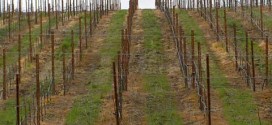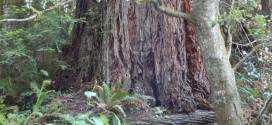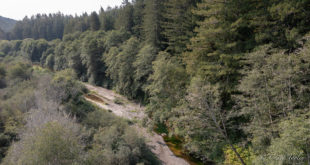| A version of this article was published in the Independent Coast Observer on August 19, 2005. |
By Julie Verran
Courtesy Independent Coast Observer, Gualala, CA
Sonoma County’s two-year debate about whether to regulate forestland conversions – usually done to plant pinot noir vineyards – will reach a high point at a Board of Supervisors hearing Tuesday evening.
The planning commission voted June 2 to recommend that the BOS adopt Option 1, to leave things as they are, with most of the responsibility for timberland conversion in the hands of the California Department of Forestry.
The CDF has a two-step process involving a conversion permit as well as a timber harvest plan. Some vineyards planned under the current process have gone back to the drawing board after legal challenges from neighbors and from groups concerned with protecting air, water and habitat.
Legal challenge of one 20 or 40-acre vineyard plan at a time has a social cost on all sides. That makes Option 3, which would prohibit land uses that require timberland conversions in “Resources and Rural Development” Land Use designations, attractive to many.
According to Margaret Pennington of the Sierra Club, Option 3 “will protect 194,000 acres of Sonoma County’s remaining redwood and conifer forests from permanent destruction…”
Option 3 is supported by such groups as Town Hall Coalition, Coastal Forest Alliance, Forest Unlimited, Sonoma County Conservation Action, Russian River Residents Against Unsafe Logging and Friends of the Gualala River.
Other citizen groups that place more emphasis on keeping land-use options open support a “no net loss” policy called Option 5, which would allow timberland conversion if other timberland is restored. That was the option recommended by staff to the planning commission, with a draft BOS motion also.
The debate hinges on what is meant by “loss” and what is meant by “restored.” [See the Open Space by Peter Baye in this issue of the ICO.] For the Sierra Club and others, “no net loss” results in gross loss of forest values such as homes for wildlife, water retention in the rugged backcountry and air free from chemical drift.
An analysis by Planner Dave Schiltgen dated April 21, gave this rationale for Option 1, later recommended by the planning commission, “that the existing and projected level of timberland conversion is not likely to significantly affect the supply of commercial timberland in the county, …” In just a few months the “grape rush” has intensified enough to make argument based on a low projected level of timberland conversion sound antiquated.
In a May document Schiltgen wrote, “…legal risk would accompany any County ordinance that simply forbids conversions in specified zones (such as Options 3 and 7).”
The difference between timber harvest and timberland conversion is that timber harvest disturbs the forest by removing trees from time to time, while timber conversion removes all parts of the forest entirely and uses the land for something else.
To read county documents go to www.sonoma-county.org/prmd/ and click on “timberland conversions,” then on the different documents.
For a local view, go to Friends of the Gualala River, www.gualalariver.org.
For a wine industry view, www.winespectator.com.
# # #
 Friends of Gualala River Protecting the Gualala River watershed and the species living within it
Friends of Gualala River Protecting the Gualala River watershed and the species living within it


